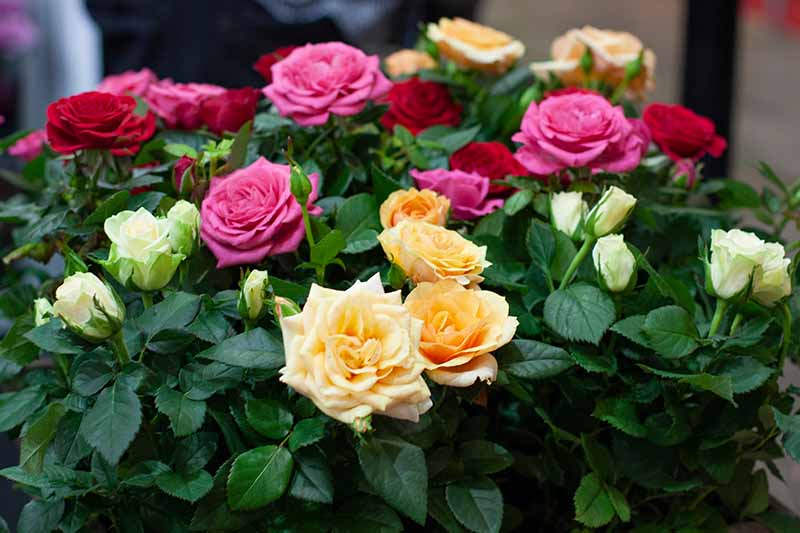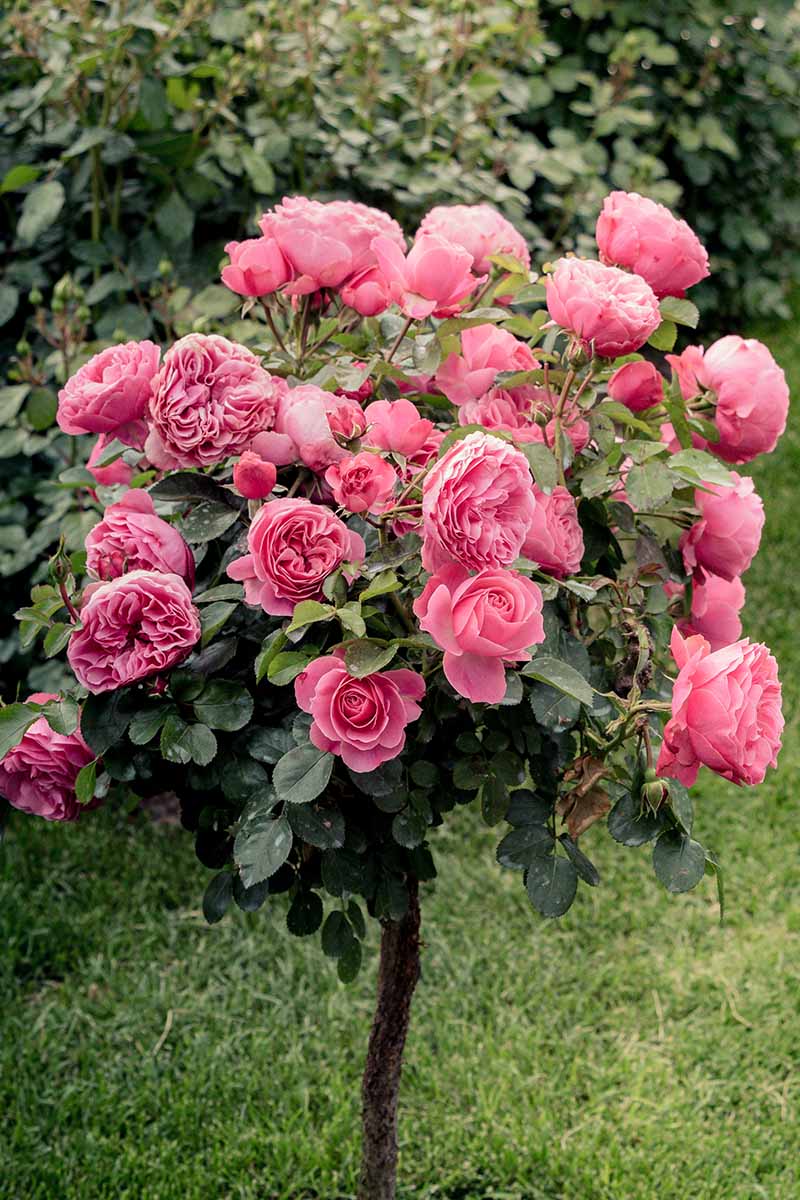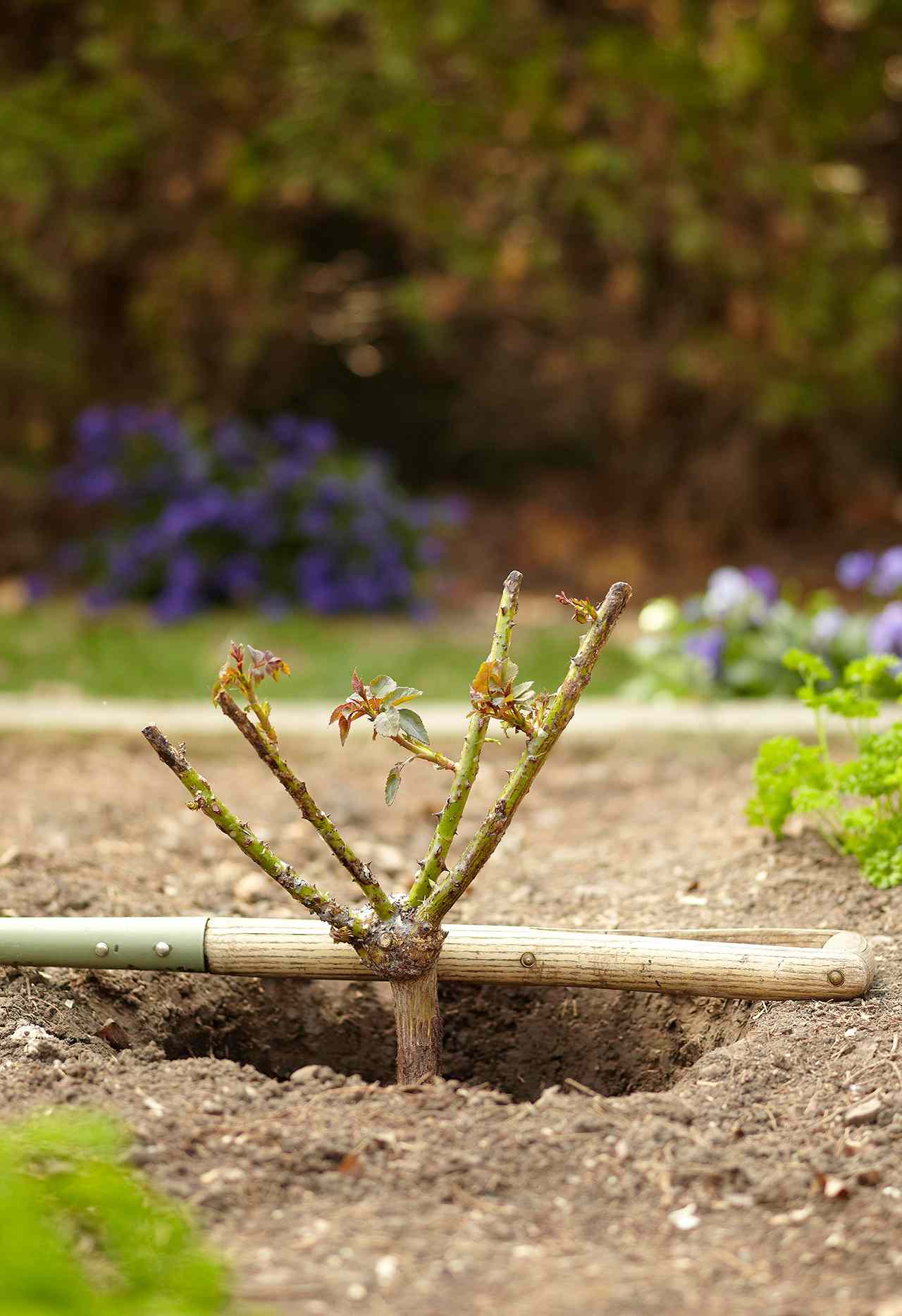Understanding the Factors that Influence Rose Bush Size
Rose bushes are one of the most popular and versatile flowering shrubs in the world, with over 150 different species and thousands of hybrids. But have you ever wondered how big do rose bushes get? The answer lies in understanding the various factors that influence their size. Climate, soil quality, watering habits, and pruning techniques all play a crucial role in determining the ultimate size of a rose bush.
Climate is one of the most significant factors affecting rose bush size. Roses grown in warm and sunny climates tend to grow larger and more vigorously than those grown in cooler and shadier conditions. In regions with mild winters and hot summers, rose bushes can grow up to 6 feet tall and 4 feet wide. In contrast, roses grown in cooler climates may only reach 3 feet tall and 2 feet wide.
Soil quality is another critical factor influencing rose bush size. Roses prefer well-draining, fertile soil that is rich in organic matter. Soil with poor drainage or inadequate nutrients can limit the growth of rose bushes, causing them to become stunted or leggy. On the other hand, roses grown in rich, fertile soil can produce robust and healthy growth, leading to larger and more impressive plants.
Watering habits also play a significant role in determining rose bush size. Roses need consistent moisture, especially during the first year after planting. However, overwatering can be detrimental to rose bushes, causing root rot and other problems. Underwatering, on the other hand, can limit growth and cause the plant to become stressed.
Pruning techniques are also essential for controlling the size of rose bushes. Pruning helps to promote healthy growth, encourages blooming, and maintains the overall shape of the plant. By pruning rose bushes regularly, gardeners can control their size and shape, creating a more compact and manageable plant.
By understanding these factors and how they influence rose bush size, gardeners can take steps to create the perfect growing conditions for their plants. Whether you’re looking to grow a compact and dwarf rose bush or a larger and more vigorous plant, knowing how to provide the right conditions is key to success. So, how big do rose bushes get? The answer depends on a combination of these factors, but with the right care and attention, rose bushes can thrive and reach their full potential.
How to Choose the Right Rose Bush Variety for Your Space
With so many rose bush varieties available, choosing the right one for your garden or landscape can be overwhelming. However, by considering a few key factors, you can select the perfect rose bush to thrive in your space. When deciding on a rose bush variety, it’s essential to think about the mature size of the plant, as well as its growth habits and bloom characteristics.
For example, if you have a small garden or limited space, a compact or dwarf rose bush variety may be the best choice. These varieties, such as ‘Knock Out’ and ‘Drift’ roses, are bred to be smaller and more compact, making them perfect for containers, borders, or small gardens. They typically grow to be around 2-3 feet tall and 1-2 feet wide, making them ideal for tight spaces.
On the other hand, if you have a larger garden or want to create a dramatic display, a larger rose bush variety may be the way to go. These varieties, such as hybrid tea and grandiflora roses, can grow to be quite large, often reaching heights of 6 feet or more. They are perfect for creating a stunning display in a larger garden or landscape.
In addition to considering the mature size of the rose bush, it’s also essential to think about its growth habits. Some rose bushes, such as climbing roses, are perfect for training up trellises or arbors, while others, such as shrub roses, are better suited for borders or hedges.
Bloom characteristics are also an important consideration when choosing a rose bush variety. Do you want a rose bush that produces large, showy blooms, or one that produces smaller, more delicate flowers? Do you prefer a rose bush with a strong, fragrant scent, or one with a more subtle aroma?
By considering these factors, you can choose the perfect rose bush variety for your space. Whether you’re looking for a compact and dwarf variety or a larger and more dramatic one, there’s a rose bush out there to suit your needs. So, how big do rose bushes get? The answer depends on the variety you choose, but with the right selection, you can enjoy beautiful blooms and a stunning display in your garden or landscape.
The Importance of Proper Planting and Care for Optimal Growth
Proper planting and care are essential for promoting healthy growth and maximizing the potential size of rose bushes. When planting a rose bush, it’s crucial to choose a location with well-draining soil and full sun to partial shade. Rose bushes prefer a slightly acidic to neutral soil pH, ranging from 6.0 to 7.0.
Before planting, prepare the soil by adding a 2-inch layer of compost or well-rotted manure. This will help to improve soil fertility and drainage. Plant the rose bush at the same depth as it was in the pot, and water thoroughly to settle the soil.
Fertilization is also critical for promoting healthy growth and blooming. Feed your rose bush with a balanced fertilizer in early spring, following the manufacturer’s instructions. You can also add a rose-specific fertilizer to promote blooming and fruiting.
Pest management is another important aspect of rose bush care. Regularly inspect your plants for signs of pests, such as aphids, whiteflies, and spider mites. Use organic or chemical controls as needed to prevent infestations.
Watering is also crucial for rose bush growth. Water your plants deeply once or twice a week, depending on weather conditions. Avoid overwatering, which can lead to root rot and other problems.
Mulching around the base of the rose bush can also help to retain moisture, suppress weeds, and regulate soil temperature. Use a 2- to 3-inch layer of organic mulch, such as wood chips or bark, and keep it a few inches away from the plant stem.
By following these tips and providing proper care, you can promote healthy growth and maximize the potential size of your rose bush. Remember, the size of a rose bush is influenced by a combination of factors, including climate, soil quality, watering habits, and pruning techniques. By understanding these factors and providing proper care, you can enjoy a thriving and beautiful rose bush that reaches its full potential.
Pruning Techniques to Control Size and Encourage Blooming
Pruning is an essential technique for controlling the size of rose bushes and encouraging blooming. By pruning your rose bush regularly, you can promote healthy growth, encourage blooming, and maintain the overall shape of the plant.
There are several types of pruning techniques that can be used on rose bushes, including deadheading, thinning, and shaping. Deadheading involves removing spent blooms to encourage the plant to produce more flowers. Thinning involves removing select branches to allow more sunlight to reach the remaining branches and promote healthy growth. Shaping involves pruning the plant to maintain a desired shape or size.
To prune your rose bush, start by removing any dead or diseased branches. This will help to prevent the spread of disease and encourage healthy growth. Next, remove any branches that are crossing or rubbing against each other. This will help to promote air circulation and prevent disease.
Once you have removed any dead or diseased branches, you can begin to shape the plant. Use a pair of sharp, clean pruning shears to cut the branches at a 45-degree angle. Make sure to cut just above a bud eye, which is the small swelling on the stem from which a new branch will grow.
Pruning can also be used to control the size of your rose bush. By pruning the plant regularly, you can encourage it to grow more compactly and maintain a smaller size. This is especially useful for rose bushes that are grown in containers or small gardens.
When pruning your rose bush, it’s also important to consider the time of year. In general, it’s best to prune rose bushes in late winter or early spring, before new growth begins. This will help to promote healthy growth and encourage blooming.
By following these pruning techniques, you can control the size of your rose bush and encourage blooming. Remember, pruning is an ongoing process, and regular pruning will help to keep your rose bush healthy and thriving. So, how big do rose bushes get? With regular pruning, you can control the size of your rose bush and enjoy a beautiful, blooming plant.
How to Train Climbing Roses for Maximum Vertical Growth
Climbing roses are a popular choice for gardeners who want to add a touch of elegance and beauty to their outdoor space. These roses are trained to grow vertically, using trellises, arbors, or other supports to reach their full potential. But how big do rose bushes get when they’re trained to climb? With proper training and care, climbing roses can grow up to 10 feet tall or more, making them a stunning addition to any garden or landscape.
To train a climbing rose, start by selecting a sturdy support, such as a trellis or arbor. Make sure the support is at least 6 feet tall to allow the rose to grow to its full potential. Next, plant the rose bush near the base of the support, making sure the soil is well-draining and fertile.
Once the rose bush is planted, begin training it to climb by gently twining the stems around the support. Use soft ties or clips to secure the stems to the support, making sure not to damage the plant. As the rose bush grows, continue to train it to climb by pruning and shaping the stems to encourage vertical growth.
One of the benefits of training climbing roses is that they can be used to cover unsightly walls or fences, adding beauty and interest to the garden or landscape. They can also be used to create a stunning display of color and fragrance, making them a popular choice for gardeners who want to add a touch of elegance to their outdoor space.
To maintain climbing roses, make sure to provide them with regular pruning and care. Prune the stems in late winter or early spring to encourage new growth and promote blooming. Also, make sure to provide the rose bush with regular fertilization and watering to promote healthy growth and development.
By following these tips and techniques, you can train your climbing rose to grow to its full potential, adding beauty and elegance to your garden or landscape. So, how big do rose bushes get when they’re trained to climb? With proper training and care, the sky’s the limit!
Common Mistakes to Avoid When Growing Rose Bushes
When growing rose bushes, it’s easy to make mistakes that can limit their growth and health. However, by being aware of these common mistakes, you can take steps to avoid them and ensure your rose bushes thrive. So, how big do rose bushes get when they’re grown correctly? With proper care and attention, rose bushes can grow to be quite large and produce an abundance of beautiful blooms.
One of the most common mistakes people make when growing rose bushes is over-watering. Rose bushes need consistent moisture, but too much water can lead to root rot and other problems. Make sure to check the soil regularly and only water when it feels dry to the touch.
Under-fertilizing is another common mistake that can limit the growth and health of rose bushes. Rose bushes need regular fertilization to promote healthy growth and blooming. Use a balanced fertilizer in early spring and again in mid-summer to provide your rose bushes with the nutrients they need.
Inadequate pruning is also a common mistake that can affect the size and health of rose bushes. Pruning helps to promote healthy growth, encourages blooming, and maintains the overall shape of the plant. Make sure to prune your rose bushes regularly, removing any dead or diseased branches and shaping the plant to maintain its desired shape.
Not providing enough sunlight is another mistake that can limit the growth and health of rose bushes. Rose bushes need at least 6 hours of direct sunlight per day to produce plenty of blooms. Make sure to plant your rose bushes in a location that receives plenty of sunlight.
Finally, not mulching around the base of the rose bush is a common mistake that can affect its growth and health. Mulching helps to retain moisture, suppress weeds, and regulate soil temperature. Use a 2- to 3-inch layer of organic mulch, such as wood chips or bark, around the base of your rose bush to provide it with the benefits of mulching.
By avoiding these common mistakes, you can help your rose bushes grow and thrive. Remember, with proper care and attention, rose bushes can grow to be quite large and produce an abundance of beautiful blooms. So, how big do rose bushes get when they’re grown correctly? With proper care, the sky’s the limit!
Maximizing Space with Compact and Dwarf Rose Bush Varieties
When it comes to growing rose bushes, space can be a limiting factor. However, with compact and dwarf rose bush varieties, you can enjoy the beauty of roses even in small gardens, containers, or tight spaces. These varieties are perfect for maximizing space and adding a touch of elegance to your outdoor area.
Compact and dwarf rose bush varieties are bred to be smaller and more compact than traditional rose bushes. They typically grow to be around 2-3 feet tall and 1-2 feet wide, making them perfect for small gardens, containers, or tight spaces. Despite their smaller size, these varieties still produce an abundance of beautiful blooms and require minimal care.
One of the benefits of compact and dwarf rose bush varieties is that they are perfect for container gardening. They can thrive in small pots and containers, making them ideal for balconies, patios, or small gardens. They also require minimal pruning and care, making them a great choice for busy gardeners.
Some popular compact and dwarf rose bush varieties include ‘Knock Out’ and ‘Drift’ roses. These varieties are known for their compact growth habits and abundance of blooms. They are also relatively low maintenance and can thrive in a variety of conditions.
When growing compact and dwarf rose bush varieties, it’s essential to provide them with the right care. Make sure to plant them in well-draining soil and provide them with regular watering and fertilization. Prune them regularly to maintain their shape and promote blooming.
By choosing compact and dwarf rose bush varieties, you can maximize space and enjoy the beauty of roses even in small gardens or tight spaces. So, how big do rose bushes get when they’re compact and dwarf? With proper care and attention, these varieties can thrive and produce an abundance of beautiful blooms.
Creating a Stunning Rose Garden with Proper Spacing and Design
Creating a stunning rose garden requires careful planning and attention to detail. One of the most important factors to consider is proper spacing and design. By spacing plants correctly and choosing complementary varieties, you can create a beautiful and thriving rose garden that will be the envy of all your friends and neighbors.
When it comes to spacing, it’s essential to consider the mature size of the rose bushes. Make sure to leave enough space between each plant to allow for proper growth and air circulation. A general rule of thumb is to plant rose bushes 3-5 feet apart, depending on the variety.
In addition to spacing, choosing complementary varieties is also crucial for creating a stunning rose garden. Consider choosing varieties that bloom at different times to create a constant display of color throughout the growing season. You can also choose varieties with different growth habits, such as compact and climbing roses, to add depth and interest to your garden.
Another important factor to consider is the overall design of your rose garden. Consider creating a focal point, such as a large rose bush or a statue, and then arrange the other plants around it. You can also use paths and walkways to create a sense of flow and guide visitors through the garden.
Incorporating other plants and features into your rose garden can also add depth and interest. Consider adding perennials, such as daylilies or coneflowers, to create a layered look. You can also add features, such as a pond or a fountain, to create a soothing and peaceful atmosphere.
By following these tips and considering proper spacing and design, you can create a stunning rose garden that will be the envy of all your friends and neighbors. So, how big do rose bushes get when they’re planted in a well-designed garden? With proper care and attention, they can grow to be quite large and produce an abundance of beautiful blooms.









